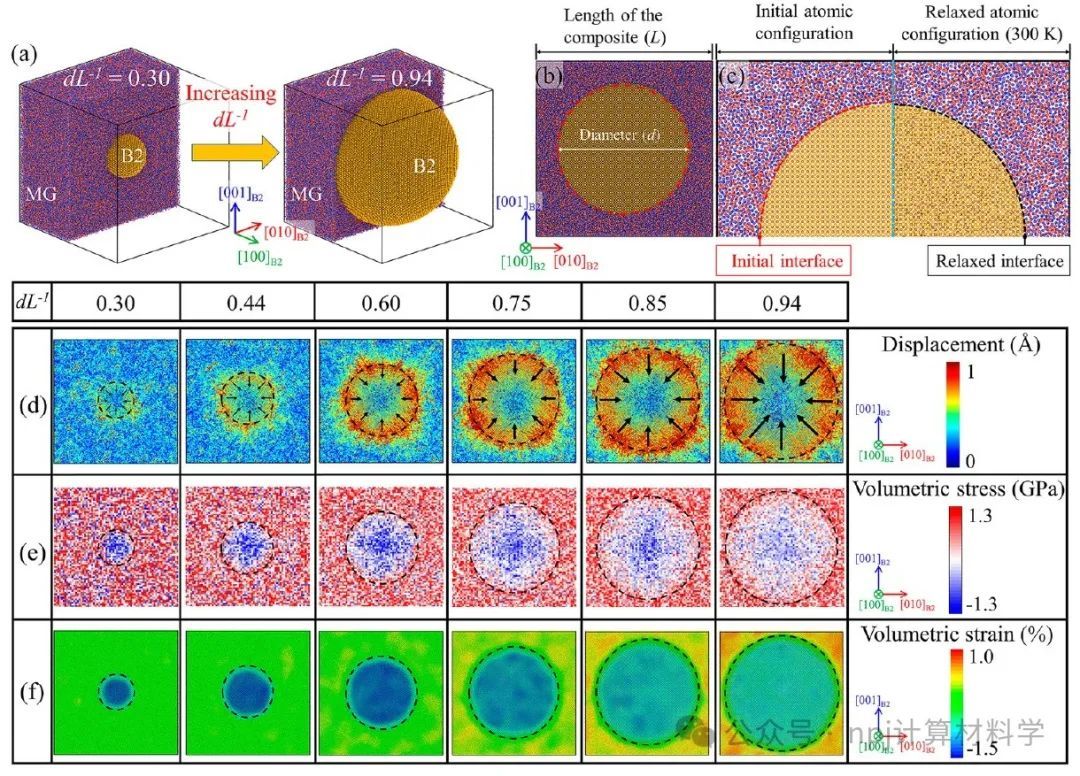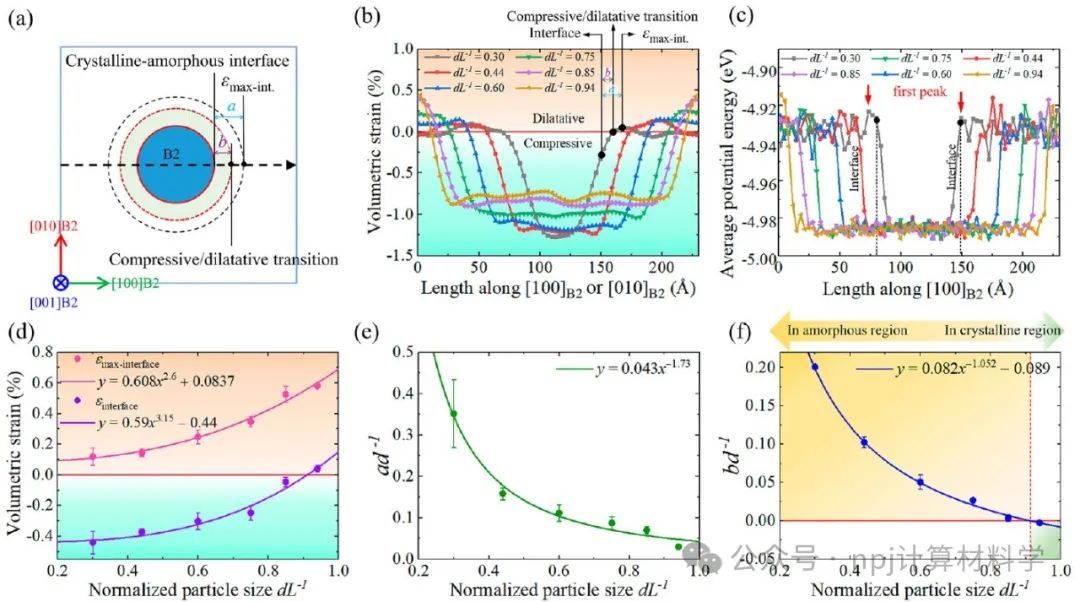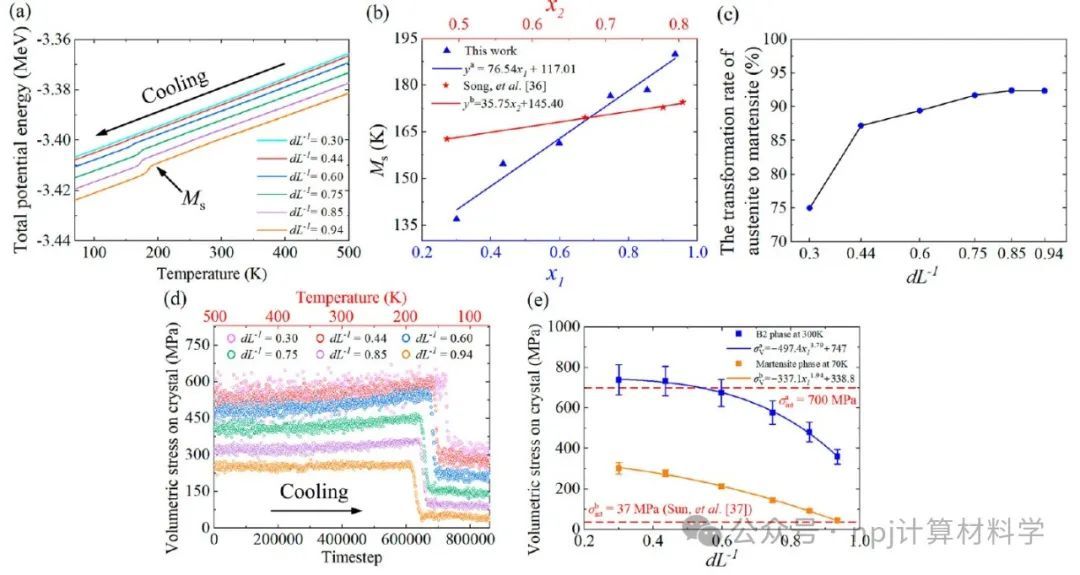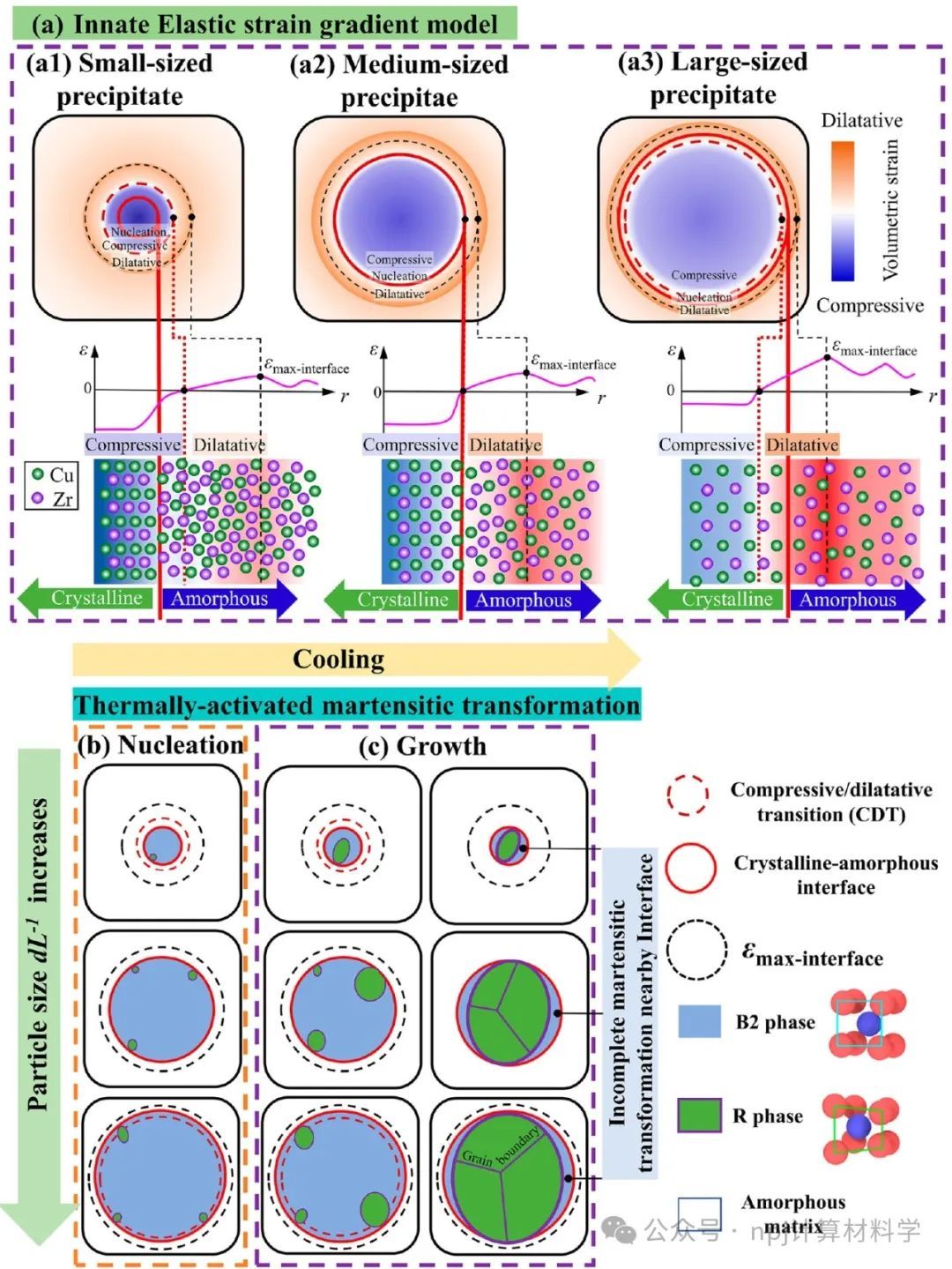针对金属玻璃固有的高脆性问题,研究人员在非晶基体中加入可转变沉淀相来抑制剪切带扩展。这种方法在晶态–非晶界面具有双重作用:一方面它由于局部应力集中而成为马氏体转变的触发点,另一方面它也能稳定这一转变,后者被认为是因为非晶基体产生的“限域效应”。如何协调界面在促进马氏体转变和剪切带形核两个看似矛盾的作用,仍是一个待解的难题。

Fig. 1 The distribution of atomic displacements, volumetric stress and volumetric strain within the 3D composite model.
由广东工业大学材料与能源学院付小玲副教授和加州大学伯克利分校Robert O. Ritchie教授领导的研究团队,采用分子动力学(MD)模拟,基于原子间势准确揭示了原子自发行为产生的非均匀弹性场,构建了不同尺寸的可转变球形B2纳米颗粒与非晶基体间的模型,从而更为精确地研究了界面弹性应力/应变场分布情况,为揭示该材料复杂的力学行为提供了新的视角。
这个模型相较于传统Eshelby理论,提出了一个新的认识:在晶态–非晶界面附近存在一个纳米尺度的界面区,其中应变呈梯度变化,从压缩逐渐过渡到拉伸。在这一特定区域,研究详细描述了晶态–非晶界面、压缩/膨胀转换过程以及界面处的最大应变,而不是简单地将其归为常规的“界面”概念。

Fig. 2 The relative distances among the compressive/dilatative transition, the exact interface and the interfacial maximum strain.
随着球形B2相沉淀物从小到大逐步增长,压缩/膨胀转换区域的位置也相应从非晶区内转移至B2沉淀物内部。界面处的应变状态也随之从压缩(对较小沉淀物)转变为膨胀(对较大沉淀物)。沉淀物和基体中的压缩(或膨胀)应力状态对马氏体转变的启动起到抑制(或促进)作用,并相应地增加(或减少)了转变的成核障碍。此外,B2相沉淀物与非晶基体间较松散(或紧密)的界面相互作用导致转变成核障碍的降低(或升高),进而影响材料的马氏体开始转变温度。

Fig. 3 The variations of total potential energy and volumetric stress associated with martensitic transformation behavior.
最大的界面应变,与“界面应变/应力集中”密切相关,其实位于界面几埃以内的非晶基体中,而非精确的界面处。界面应力集中的数值明显高于精确界面的应变,并随着沉淀物尺寸的增加而增长。通过精准调控马氏体转变比例和界面应力集中度,可以大幅提升“转变介导的加工硬化和塑性”效应,有效解决即便在低温条件下也存在的强度与延展性的平衡问题。该文近期发表于npj Computational Materials 9: 226 (2023).

Fig. 4 The innate interfacial strain gradient model for various sized precipitate enhanced metallic-glass composites.
Editorial Summary
High brittleness in metallic glass: MD simulation
To address the inherent high brittleness of metallic glasses, researchers have introduced transformable precipitates into the amorphous matrix to inhibit the expansion of shear bands. This approach has a dual role at the crystalline-amorphous interface: on one hand, it becomes a trigger point for martensitic transformation due to local stress concentration, and on the other hand, it stabilizes this transformation, which is considered to be due to the “confinement effect” produced by the amorphous matrix. How to coordinate the interface’s seemingly contradictory roles in promoting martensitic transformation and nucleation of shear bands remains an unresolved issue.
A team led by Prof. Xiaoling Fu from School of Materials and Energy, Guangdong University of Technology and Prof. Robert O. Ritchie from Department of Materials Science & Engineering, University of California, USA, established an innate interfacial elastic strain gradient model of a transformable B2 precipitate embedded in an amorphous matrix based on MD simulations.
Compared to the Eshelby solution, this model proposes a nanometer scale interfacial region adjacent to the crystalline-amorphous interface which experiences gradient strain transitions from compressive to tensile. In this region, the crystalline-amorphous interface, the compressive/dilatative transition, and the interfacial maximum strain were characterized and differentiated instead of addressing them all as “interface” in a conventional fashion.
When the size of the spherical B2 precipitates gradually increases from small (dL-1 < ~ 0.75), medium-sized precipitates (~0.85 < dL-1 < ~ 0.94) to very large precipitates (~0.94 < dL-1 < 1), the compressive/dilatative transition region locates from inside the amorphous region to inside the B2 precipitate. The actual interface strain transits from compressive (for dL-1 < ~ 0.91) to dilatative (for dL-1 > ~ 0.91). The compressive (dilatative) stress state in the B2 precipitate and amorphous matrix serve to prohibit (assist) the initiation of martensitic transformation and increase (decrease) the nucleation barrier of the transformation. The looser (close-packed) interfacial interaction between the B2 precipitate and the amorphous matrix decreases (increases) the nucleation barrier of the transformation, thus increasing the Ms temperature.
The interfacial maximum strain, which is likely related to the “interfacial strain/stress concentration”, is located a few Ångstroms away from the interface and inside the amorphous matrix, instead of at the “exact” interface. The value of the “interfacial stress concentration” is always higher than the strain at the “exact” interface and increases as the precipitate sizes in the BMGCs are enlarged. By properly manipulating the transformation fraction of the martensitic transformation and interfacial stress concentration, the “transformation-mediated work hardening and plasticity” effect can be maximized to overcome the strength-ductility trade-off even at cryogenic temperatures. This article was recently published in npj Computational Materials 9: 226 (2023).
原文Abstract及其翻译
The innate interfacial elastic strain field of a transformable B2 precipitate embedded in an amorphous matrix (嵌入非晶基体中可转变B2相沉淀物的固有界面弹性应变场)
Xiaoling Fu, Yujun Lin, Mixun Zhu, Kai Wang, Jiaqing Wu, Xing Tong, Wenli Song, Ming Jen Tan, Yuanzheng Yang, Jun Shen, Gang Wang, Chan Hung Shek & Robert O. Ritchie
Abstract
When a transformable B2 precipitate is embedded in an amorphous matrix, it is often experimentally observed that the crystalline-amorphous interface not only serves as an initiation site for the martensitic transformation due to local stress concentrations, but also as an inhibitor to stabilize the transformation, the latter being attributed to the “confinement effect” exerted by the amorphous matrix, according to the Eshelby solution. These two seemingly incongruous factors are examined in this study using molecular dynamics simulations from an atomic interaction perspective. An innate strain gradient in the vicinity of the crystalline-amorphous interface is identified. The actual interface, the compressive/dilatative transition, and the interfacial maximum strain are investigated to differentiate from the conventional “interface” located within a distance of a few nanometers. Our innate interfacial elastic strain field model is applicable for the design of materials with a higher degree of martensitic transformation and controllable stress concentration, even in cryogenic environments.
摘要
当在非晶基体中嵌入可变形B2相沉淀物时,实验常常显示出晶态–非晶界面具有双重作用:一方面它由于局部应力集中而成为马氏体转变的触发点,另一方面它也能稳定这一转变,后者被认为是因为非晶基体产生的“限域效应”。这一效应得到了Eshelby理论解的支持。本研究通过原子级相互作用的分子动力学模拟,探讨了这两个看起来矛盾的因素。我们发现在晶态–非晶界面附近存在固有的应变梯度。通过详细研究实际的界面,压缩/膨胀转变区域,以及界面的最大应变,我们进一步区分了这些特征与通常位于距离几纳米范围内的传统“界面”的不同。我们提出的固有界面弹性应变场模型,为设计能在包括低温环境在内的各种条件下,实现高度马氏体转变和可控应力集中的新材料提供了理论依据。



























 1853
1853

 被折叠的 条评论
为什么被折叠?
被折叠的 条评论
为什么被折叠?








